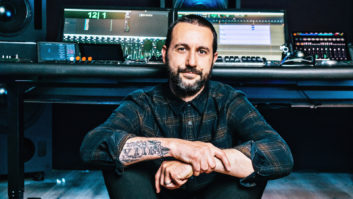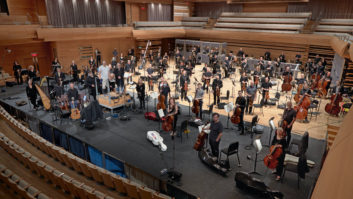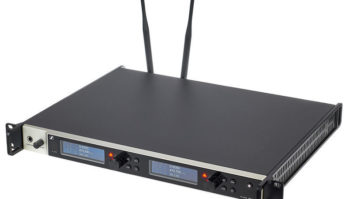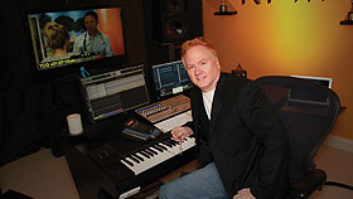Despite an increasing number of productions going out of state and abroad, Southern California is still a filmmaking hub. When it comes to scoring, producers have a multitude of facilities to choose from, from the massive Todd-AO to small independent stages. Paramount’s Scoring Stage M is neither the largest nor the smallest facility in Hollywood. It can hold orchestras in the 75 to 100-person range, while retaining a special quality that music-scoring artisans find very appealing, what many call “a sweet sound.”
“Technically, all of the places basically have the same equipment,” notes independent contractor John Rosenberg. Initially a player for 15 years, he’s had a 30-year association with Scoring Stage M. “Personally, I like the sound of this room a lot better than some of the bigger stages. Different composers like different stages, but most of the guys I work with like this place.”
“Scoring is the icing on the post-production cake,” states Stephanie Murray, executive director of Scoring Stage M. “It’s the music, and everyone gets excited about it. Also, it’s the last element before going to dubbing, and finally, everyone knows how important it is.”
Murray is the point person for the facility and has been there since 1986. She says her mission, first and foremost, revolves around accommodating clients’ needs. The myriad top-flight composers and production companies who have worked there rolls off her tongue effortlessly, like remembering old college friends. Essentially, most of the projects that come through Stage M are feature scores, but have included sessions for studio logos, CD recording dates and even served as a rehearsal hall for the Oscars. “I think 101 Dalmatians, the remake, was one of the bigger jobs that came through here,” Murray recalls. “We also had The Horse Whisperer, and not too along ago Zoolander. Just about every Star Trek film with the exception of one has been done here.” Additionally, the facility donates time for student orchestrators to obtain experience on a real scoring stage.
TURNING BACK TIME
In 1932, the facility was transported from what is now the Sunset-Gower Studios on a flatbed pulled by mules. From then until 1968, Paramount’s own orchestra primarily used it. Glen-Glenn Sound then leased the stage until the Record Plant took over the lease in 1982. The Record Plant stayed on the lot until 1989, but gutted the area upon departure. Basically inoperable, the stage remained dormant until 1992, when a major revamping was undertaken to make the stage competitive again.
David Schwind, from the San Francisco-based design firm Charles Salter & Associates, was the consultant for the acoustical enhancements, while Para-mount’s engineering department handled equipment and wiring details. Together, they constructed a facility that was state-of-the-art but maintained the essence of the renowned “sweet sound.” However, the room had to be altered, which affected its often-touted multifaceted aspects: During the Record Plant era, the stage featured tunable louvers that enabled it to transition easily from recording small rock acts and jazz combos to large classical orchestras.
Danny Wallin, a recording engineer/mixer since the late ’40s with more than 500 films to his credit, was a staff mixer at the facility during the Record Plant years and has seen lots of technology changes over time — from recording direct-to-disk to recording to hard disk. Elmer Bernstein and Bill Conti are his two favorite conductors, while Sony and Paramount rank as his top picks for scoring stages. “I just like the sound of the room,” Wallin says of the Paramount stage. “I like the string sound a lot, and the room just has a lot of definition in it. Overall, it’s very pleasant and clean, with a nice singing quality.”
Wallin describes the louver system that was installed and used by the Record Plant: “They were 14-foot-long panels that were soft on one side and hard on the other. So, you bring them down a track and you could tune them up if it was live, spin them to make it deader, or go in between and diffuse them. You could do whatever you wanted. For example, I did 48 Hours here with two drummers, a steel drummer, strings and a brass section tuned down. It sounded great, and the next day we tuned them up and did a classical score.”
Paramount’s management decided against retaining the tunable walls and opted to dedicate the room to classical scoring. “This [room] is kind of locked into one sound now,” Wallin notes, “but it’s a good sound, with the original acoustics updated. The only thing that’s different now is that we were able to do more before. But I remember when I came here to visit someone in 1946. It looked like the inside of an old barn — sounded good, though. Then Glen-Glenn got ahold of it and thoroughly modernized the room, but it didn’t work very well. Then we [Record Plant] got it and revamped it again. We were busy then; sometimes, we’d do three different sessions a day.”
THE REDESIGN
Consultant Schwind’s memories of the old scoring stage are less romantic. His firm did a feasibility study for Paramount in 1989 when the room was first shut down. After a detailed analysis, it was determined that modifications were necessary to produce a consistently desirable sonic output for orchestras. “We didn’t use any of the original sound-absorbing materials, except on the ceiling,” states Schwind. “We created a pattern of pyramids and sound-absorbing panels between them. They did have these large wood door things [louvers] that were adjustable. We found that we could put them together and make a V-shaped diffuser out of them. So they were attached together and fixed in place.
“The variability was actually kind of a problem. It was always thought that if you had something that varied, you’d never know if someone had moved one of the variable devices or something else changed, especially when you went out in the middle of a session. So they were eager to get rid of that variability. For music, there are genre-specific reverberation times that are good. Yet if a scoring stage doesn’t have variable acoustics like Skywalker [Sound], you have to make a compromise. Those are between the more modern amplified genres and orchestral, which can tolerate a long reverb time. The Todd stage has a reverb time of 1.8 seconds, but we decided with the Paramount people that the reverb should be 1.2 seconds.”
Schwind also conferred with some of the mixers who worked at the facility. He says they were pretty much in accord with him and Paramount’s management, and especially helpful when it came to construct the new control room. “We wound up basically demolishing the old control booth and building one with much better sound isolation,” Schwind recalls. “The booth is on the same floor as the stage, and we didn’t want structure-bearing noise transmission between the two. We put in a concrete floating floor to better isolate the control booth. With that in mind, we changed the design of the control area significantly. It used to be wide and not very deep. We turned that around and made it deeper than it is wide. That allowed us to get the machine room alongside it.”
For Robert Spano, the chief engineer of post-production facilities at Paramount — a responsibility that includes picture editorial, sound editorial (not for scoring), ADR/Foley and transfers — Scoring Stage M’s refabrication was a work in progress during his initial days on the lot 10 years ago. “It was all rewired, everything was new, all new cables with mic panels in six places throughout the room,” he recalls. “The podium can be set up anywhere in the room, and for scoring, we have an editor’s table that has a computer going through it for video wipes, which can either be onstage or in the control room.
“We didn’t know where anyone wanted anything, so I said just make it so that anyone can put anything anywhere. Five years ago, we moved the [projection] screen back [about 10 feet]. That involved a tremendous amount of work because there were concrete film vaults there. It took weeks to move those vaults because they were bombproof. That gave us another 30,000 cubic feet and opened up the room a lot. The reason we did that was so that we could put more musicians in the room, but it made it sound better, too.”
THE STAGE TODAY
From a technical standpoint, Spano likes to keep things simple and makes upgrades as customer and performance demands call for them. For example, there’s no routing system employed in the machine room or control room area. Instead, there are three sets of patchbays running on +4 voltage, which are connected by 4-inch conduit running underneath the floorboards. The mixing console is a Neve VR with Flying Faders, which has been expanded from 72 to 96 input/outputs. “It’s a huge console now,” Spano remarks. “The demand for more inputs was tremendous. Not just for recording, but also to mix. We have three 24-tracks coming in soon, and we’re using two 48-track decks sometimes. So we needed to be able to accommodate all of that stuff, along with external mic preamps.”
DMT Rentals of Burbank has built a Maserati Pro Tools HD-3 system that will live on Stage M. It’s configured with 48 channels each of digital and analog I/O, with, among other innovations, the ability to record 192kHz and 96kHz simultaneously.
For viewing purposes, there’s a series of monitors in the control room and out on the stage. Also, a Sharp XG2000 video projector is available for full theater-like viewing. Other equipment that a client might want or need can be rented. Like most operations in Hollywood, the facility is client-driven, which translates to “whatever you want; From premier chefs to cutting-edge file-based systems, we’ll get it for you.”
Summing up the facility, Spano says, “It feels down-home; you walk in there and feel completely different from the rest of the lot.” Schwind adds, “I think it fits very well for the market that they are interested in pursuing. I think it’s been a great success. Frankly, it’s always a good thing when you’re called back and the client likes your work, and it stands the test of time.”






